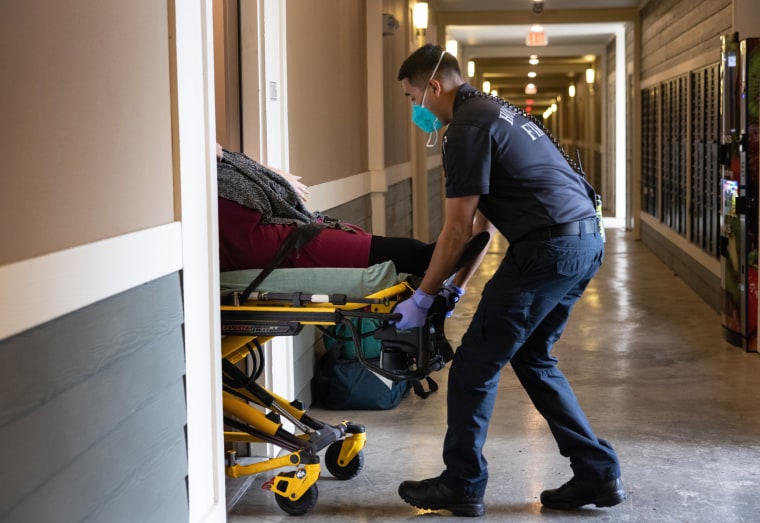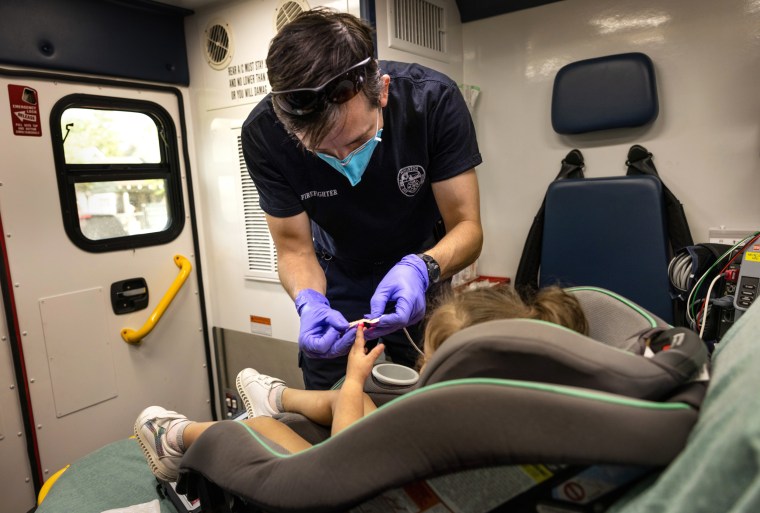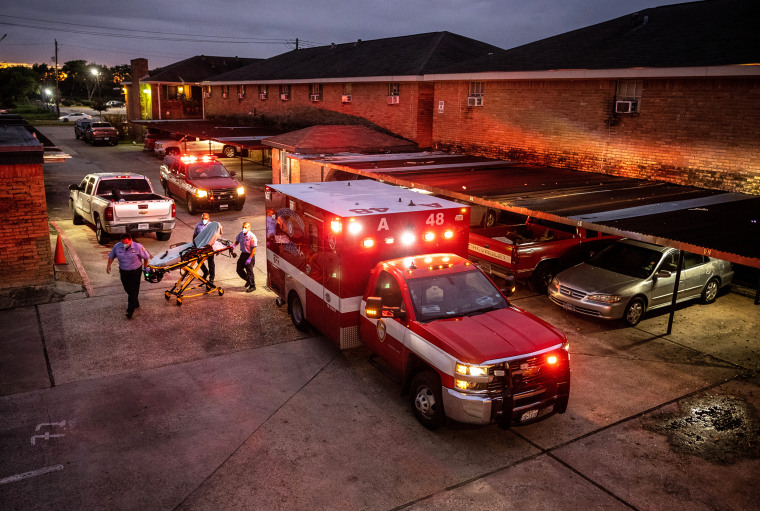The pandemic-induced shortage of emergency medical technicians and paramedics nationwide is so dire that ambulance service providers warn of sharp cuts to services and longer waits for 911 calls — even when it’s a matter of life or death.
Companies have had to close, consolidate or come up with new strategies to answer calls, said American Ambulance Association President Shawn Baird, who added that there is simply not enough EMS personnel to cover calls in many parts of the country, especially during the pandemic.
The loss of staff to pandemic-related burnout and low wages has created a vicious cycle, requiring greater dependence on those workers who have stayed on. The situation has deteriorated to such a degree in recent months that ambulance services and industry leaders are pleading with Congress and state legislatures to help.
"The magnitude has really blown up over the last few months," Baird said. "When you take a system that was already fragile and stretched it, because you didn't have enough people entering the field, then you throw a public health emergency and all of the additional burdens that it put on our workforce as well as the labor shortages across the entire economy, and it really has put us in a crisis mode."
It's a crisis that has made it difficult to hire and even harder to retain EMTs and paramedics, according to a AAA survey of 258 EMS organizations across the country.
In 2020, nearly a third of the workforce left their ambulance company after less than a year, the survey said. Eleven percent left within the first three months.
"It's almost unmanageable," said Ken Cummings, who leads Tri-Hospital EMS in Port Huron, Michigan. "I don't think any EMS provider wants to go out in public and say that your service might be interrupted, but the reality is that because of the extremely low workforce situation right now, we are going to start to see delays. We're already seeing that throughout the country right now."
Cummings said he currently has 10 openings, about 10 percent of his workforce. He's currently paying double overtime to fill the gap left by those empty positions, but that has increased the average work week of his paramedics by at least eight hours.
The amount of money he's paying in overtime is also becoming untenable, and his workers are losing interest in the extra cash.
"We're spending money today that we're hoping we get tomorrow, to be real honest with you," he said. "It's not a long-term solution."
There are an estimated 1,000 open EMS positions in Michigan alone, Cummings said.
The good news for Cummings is that he has a handful of students who will graduate next year from the paramedic program, but the churn is constant. The Republican-controlled Legislature and Gov. Gretchen Whitmer, a Democrat, also agreed to allocate $12.9 million of the state's budget to increase reimbursement rates.
But that has not slowed the revolving-door nature of the job. Among full-time EMTs, 47 percent reported in 2020 that the reason for leaving was for a career or occupation change, according to the survey. That number is 45 percent among paramedics.
"In my experience running an EMS service, I've seen more than a few employees get into the industry and leave within six months," said Judd Smith, the program director of Texas EMS School in Abilene. "I'll see people work for three weeks and then move on to the next thing."
The decline in Texas has been particularly substantial. By mid-August, only 27 percent of licensed EMS professionals had submitted a patient care record, according to the Texas Department of State Health Services, meaning that over 70 percent of licensed Texas EMTs did not work on an ambulance in the first eight months of the year. That represents a significant drop from the 43 percent of EMTs who submitted reports in 2020 and the 45 percent who did in 2019.
The circumstances have pushed the American Ambulance Association and National Association of Emergency Medical Technicians to send a letter to Congress last week pushing for a hearing to address the shortfall and asking for more funding to increase wages.
The letter warned that "our nation’s EMS system is facing a crippling workforce shortage, a long-term problem that has been building for more than a decade. It threatens to undermine our emergency 9-1-1 infrastructure and deserves urgent attention by the Congress."

'We're hemorrhaging'
The pandemic has made a bad labor problem worse.
The spread of the virus, the frequency of calls, worry of potential infection and the necessary safeguards that emergency personnel must take to protect themselves have created additional stress that has caused many to leave the field, providers said. Their departure has then increased the need for those who remain to work overtime, pushing even more to leave the field.
The nationwide health emergency also caused many EMT and paramedic courses to shut down, meaning there is a dearth of students coming into the industry.
"We're not bleeding any longer — we're hemorrhaging," said Gary Wadaga, who operates Bay Ambulance in Michigan's Upper Peninsula.
Ambulance companies have faced years of workforce challenges that has damaged their ability to respond to calls quickly, but the situation is getting worse.
Last year, because an ambulance service closed south of his company's service area, Wadaga had to take on an additional 100 square miles of territory. Now he covers 1,500 square miles and receives about 1,000 calls a year with six paramedic positions.
The trouble is, he's been unable to fill two spots and has another two workers on leave, leaving him and one other person to respond to every emergency call that comes in.
"I've not seen it this bad in 41 years, and you can't just set that aside," said Wadaga, adding that the increasing demands of the job have caused him great anxiety. "You want to be there for your community, but the fact that one day we're not going to have enough people absolutely bothers me."
Ambulance companies once had the luxury of considering applicants, but that appears to be a concept of the past. Now companies are actively recruiting and even going after one another's employees because the pool of eligible workers is so small.
"Overall, it's robbing Peter to pay Paul," said Baird, "because every community needs these folks."
A death spiral?
Wadaga and other ambulance service operators said the pandemic has increased the viciousness of a labor shortage and put the nation's emergency medical system at risk of a "death spiral" that could be difficult to pull out of.
The salary requests of a shrinking workforce are getting higher as wages remain stagnant. The 2020 median pay for EMTs and paramedics was $36,650 per year or $17.62 per hour, according to the Bureau of Labor Statistics. That's about a 7.5 percent increase since 2011.
Advocates said the wages don't match the requirements of the job anymore.
"When you're an EMS provider putting your life on the line and entering into a closed environments with infectious patients and you can make more money to work in an Amazon warehouse, it becomes really difficult to retain people," said Robert Luckritz, who serves as chair of the National Association of Emergency Medical Technicians' EMS Workforce Committee.
But it's not just retail and warehouse work that's calling. Luckritz said that hospitals facing their own nursing and health care worker shortages are at times actively recruiting EMT and paramedics, promising higher wages, better hours and increased benefits.
That's an issue Luckritz and his colleagues are attempting to work on, but it's a challenge. They need more money to hire more people, but ambulance company rates are set by insurance providers and the government when it comes to Medicare and Medicaid, which both contribute to the vast majority of calls, Luckritz said.

"Unlike much of the other industries across the country ... we're not able to raise our prices — our prices are set by the government," he said. "So with reimbursement not keeping up with our costs, it makes it very difficult for us to compete for the workforce."
The fear is that if the country doesn't face these problems now, they will be unfixable down the line.
Baird, the AAA president, said that if things spiral too far down, "we can’t get people to even enter the field because it looks too daunting."
"We have to turn this around," he said.
One silver lining is that online EMS programs, such as Smith's Texas EMS School, are seeing increased interest — even as nationwide there is a decline in enrollment in traditional programs.
The number of applications for their EMT program, which can be completed in 10 to 18 weeks via a mix of online coursework and hands-on clinical and field experience, jumped from 495 applicants in 2019 to 1,469 in 2021.
The jobs certainly are there waiting for them at graduation.
"I don't know of any one of our students that doesn't get hired within the first week of getting licensed," Smith said. "We've even had a big number of them get hired before they even received their certification, so they start working as soon as they're done."

